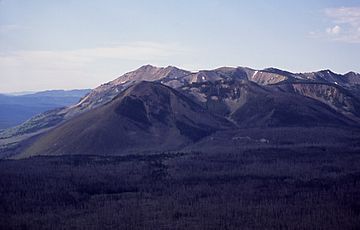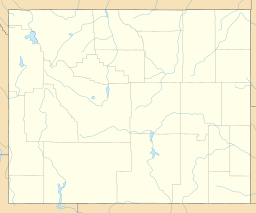Factory Hill facts for kids
Quick facts for kids Factory Hill |
|
|---|---|

Red Mountains, Factory Hill in foreground
|
|
| Highest point | |
| Elevation | 9,527 ft (2,904 m) |
| Geography | |
| Parent range | Red Mountains |
| Topo map | USGS Mount Sheridan |
Factory Hill is a mountain peak located in the beautiful Yellowstone National Park. It stands tall at about 9,527 feet (2,904 meters) above sea level. You can find it in the Red Mountains range, just north of another peak called Mount Sheridan. To its west is the active Heart Lake Geyser Basin, a place full of steaming hot springs.
This mountain has an interesting history behind its name. Early explorers first called it Red Mountain. This name later moved to the entire mountain range where Factory Hill is found.
How Factory Hill Got Its Name
In 1885, a group of scientists called the Hague Geological Survey gave the peak its current name, Factory Hill. They named it after a description from Nathaniel P. Langford. He was an explorer who visited the area in 1871.
Langford's Expedition
Nathaniel P. Langford was part of a famous journey called the Washburn–Langford–Doane Expedition. This group explored parts of Yellowstone in 1870. Langford wrote about his experiences in a magazine called Scribner's Monthly.
While camped near the south part of Yellowstone Lake, Langford saw something amazing. He looked across an inlet and saw steam rising from many hot springs. These hot springs were part of the Heart Lake Geyser Basin.
A Steaming View
Langford described the scene like this:
Through the hazy atmosphere we beheld, on the shore of the inlet opposite our camp, the steam ascending in jets from more than fifty craters [Heart Lake Geyser Basin] giving it much the appearance of a New England factory village.
– Nathaniel P. Langford, Scribner's, February, 1871
He thought the steam and sounds from the geysers looked and sounded like a busy factory town. Because of this description, the mountain nearby was later named Factory Hill. It's a reminder of how the natural world can sometimes look like human-made places.


